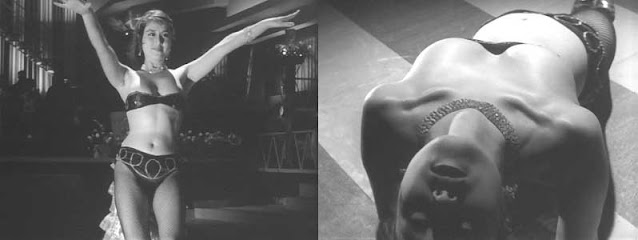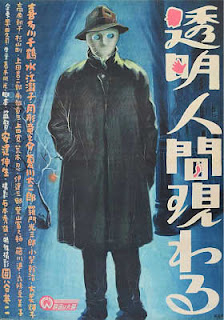
Aka - Tomei Ningen Arawaru
This Japanese take on The Invisible Man has faint echoes of that classic 1933 film - a potion that makes you invisible and its homicidal effects on the person over time - but it is otherwise an entirely different story. Director Shinsei Adachi buries it within a story of family, a love triangle or quadrangle and crime. It is not exactly Ozu but take out the Invisible Man and you have a family drama. This 1949 film for Daiei is apparently one of the earliest existing films that qualifies as a tokusatsu film. That is a new term I just learned! I will use it often I am sure - but basically it means the use of special effects as in the Kaiju and sci-fi films that were soon to come. And who is behind these special effects? Who else but the master, Eiji Tsuburaya, who would supervise so many of the Kaiju films for Toho. At this time, he was actually being blacklisted by the American Occupation for making those nifty war time propaganda films using miniatures and models to depict battles so realistically that they fooled people. But he was able to set up his own production house which allowed him to sidestep the blacklist.

This gets a bit confusing at times as if perhaps snippets of the film were lost but it is an entertaining outing. Scientist Nakazato (Ryûnosuke Tsukigata) asks his two assistants Segi (Daijirô Natsukawa) and Kurokawa (Kanji Koshiba) how their projects are coming along. Their projects? To be able to turn invisible. They are working separately and along different lines but both admit they are not there yet. Nakazato tells them that as a prize the one who gets there first gets to marry his daughter Machiko (Chizuru Kitagawa). They are both in love with her but this feels a bit feudal and Machiko doesn't quite know who to root for though she is leaning towards Segi. Unknown to them Nakazato has already invented an invisible serum but not tried it on a human and has no reverse serum. It also seems to make the animals go crazy eventually as we see later when an invisible cat goes out of its way to break every vase in the house!
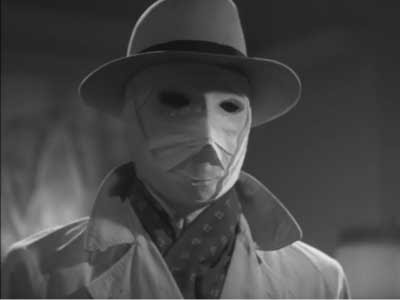
Nakazato tells his secret to what he considers to be a family friend, Kawabe (Shôsaku Sugiyama), whose nervous puffing on a cigarette tells the audience that he is soon to be the villain. And he is as he kidnaps the scientist and fools Kurokawa into taking the serum. He is also in love with Machiko. You might think that Machiko would be a raving beauty with a sparkling personality but the actress is rather plain and the character a little dull. Perhaps that was the perfect Japanese wife back then. Kurokawa starts to go nuts and is told that he can get the anti-serum if he steals these precious diamonds that his sister Ryoku (Takiko Mizunoe) owns. Interestingly, Ryoku is seemingly portrayed as a lesbian with her manly apparel. Takiko has a large write-up on Wikipedia and had a fascinating life. She spent most of her career on stage and was famous for her cross-dressing male roles. She later produced Season of the Sun, Crazed Fruit, Rusty Knife among others.

(Not from this film)
The special effects I would imagine are done in the same way that all those Universal Invisible films were done - chairs topple, footprints made, vases broken - which is all you need really.
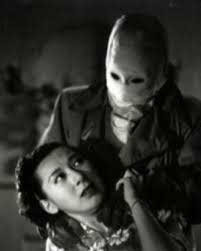
The Invisible Avenger (1954) - 6.5

Aka - Tômei ningen
Aka - The Invisible Man
Five years after the 1949 The Invisible Man Appears, an Invisible man returns to Japan but from a different studio. That first one came from Daiei while this is from Toho, in the same year they produced the first Godzilla film. Probably not coincidentally, Eiji Tsuburaya who supervised the special effects for the Daiei film was now at Toho at the beginning of a great run of sci-fi, monster and fantasy films. He was no longer being blacklisted by the American Occupation and could officially join a studio. This only runs for 70 minutes and to some degree is more a drama than a fantasy film with the special effects kept to a minimum. But it is a solid drama taking in a blind girl, a clown, a night club singer, a nosy reporter and the Yakuza.
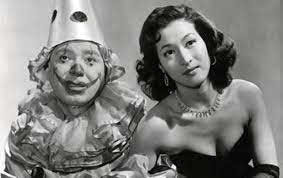
It begins with a driver thinking he has run over something on a busy Tokyo street but nothing is there - until the blood starts flowing from beneath the car. Then a man appears. Dead. In his pocket they find a note saying he and others had been part of a military experiment to turn agents invisible. He could not take it anymore and killed himself. All the rest he writes are dead except for one. An ensuing panic starts up when a man claiming to be the invisible man wrapped in bandages along with others begin robbing stores. The Invisible Ray was invented by a professor by accident who is now dead. There is of course no reversing it.
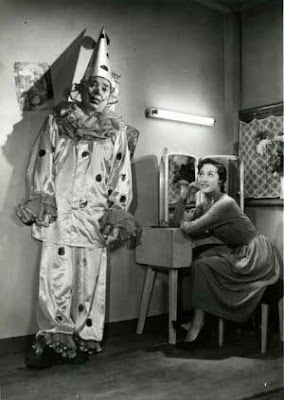
The Yakuza operating out of a nightclub are actually behind the robberies and they pressure an old man who has a blind granddaughter to look the other way during a robbery. Being a nightclub, we get the requisite songs and dances - Michiyo (Miki Sanjô) is the main performer and also knows what is going on in the club. She lives across from the blind girl Mariko and her grandfather. In this mix is a sad looking clown (Seizaburô Kawazu) who is hired to carry around advertising signs for the club and he walks around all day. He is also a friend to the blind girl and the singer. The invisible invisible man doesn't really show up till late in the film when he does the big reveal.
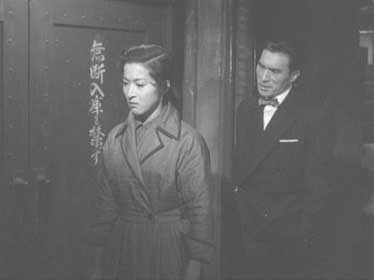
Other fx are the basics - but always fun - guys pretending to bump into something or getting hit, visible footsteps and my favorite in the film - him playing drums, an accordion and a trumpet while the gangsters try and shoot him. One nifty scene that seems to have little relevance to the film is when a door opens in the club and a girl is hanging by her hands from the ceiling in a sexy outfit being whipped for doing something wrong. Probably got the drink order wrong. There is an ending ripped from White Heat except we get no "Made it, Ma! Top of the world!". Directed by Motoyoshi Oda who the following year directed Godzilla Raids Again which according to some almost sunk the Godzilla franchise right at the beginning.

The Invisible Man vs The Human Fly (1957) - 6.5

Aka - Tômei ningen to hae otoko
Think about waking up to this newspaper headline. "Homicidal Human Fly at Large in Tokyo". That might make you have another cup of coffee or go back to sleep. By 1957 Tokyo was used to invisible men and giant monsters tromping down on them, but now on top of that a killer human fly. Honey, maybe it's time to move to Yokohama. This is the third and final (as far as I know) of the Invisible Men films in Japan - The Invisible Man Appears in 1949 from Daiei, The Invisible Avenger in 1954 from Toho and now in 1957 the ball is back in Daiei's court with The Invisible Man vs The Human Fly. Taking two horror classics from Hollywood and combining them is a great idea. Eiji Tsuburaya who supervised the special effects in the first two films is not around for this one and that seems fairly apparent. They are not very good - kind of tacky really. The Invisible Man gets short shrift in the film and the Human Fly is more comical than scary. Still, it is a fun film that has a noir murder mystery quality around it, but it runs a good 20 minutes too long.
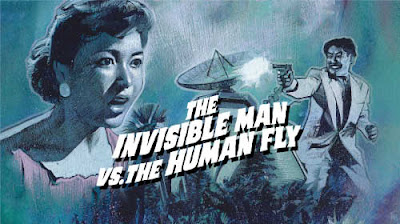
On a plane flying into Tokyo a man is murdered but it seems impossible as no one could have. The police are baffled. Heading the investigation is Detective Wakabayashi (Yoshirô Kitahara) who goes to question Professor Hayakawa who was on the plane. He is with his daughter Akiko (Junko Kanô) and friend Tsukioka (Ryûji Shinagawa). The detective sighs and says only an invisible man could have done it. Hmmm. The other three gulp and look guilty. Well , , , let me show you our lab in the back yard and takes him into a lab that looks like control at Cape Kennedy. We have in fact invented a ray that makes you invisible but have not tried it on humans yet. And it has the Big Bugaboo - it can't be reversed.
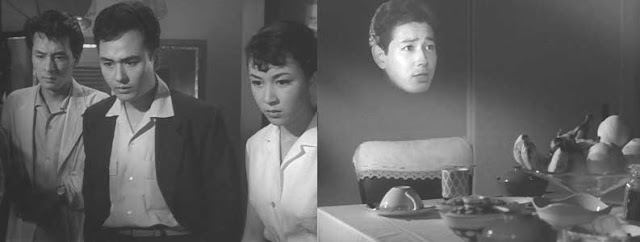
The only clue that Wakabayashi has is a matchbox from Club Asia owned by Kuroki. Cue to the sizzling floorshow with the sexually enticing Mieko (Ikuko Môri - in a few Zatoichi films) writhing on the floor to the full orchestra in a ruffled dress and well-exposed cleavage. The camera likes shooting down on her from over her shoulder like a Peeping Tom. She has very little to do with the film but I am not complaining. A woman is murdered in broad daylight - as she dies, she points to the sky. Then a man while a cop is following him is stabbed to death - and the cop can only recall there was a buzz and the victim kept brushing away something.
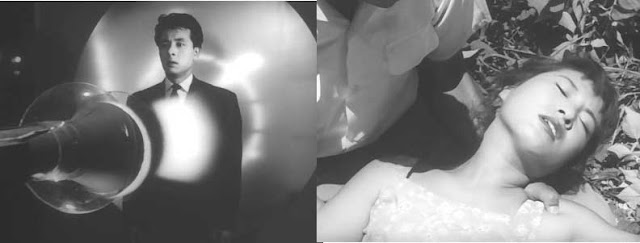
Yes, it's the homicidal fly. Killing whoever annoys him. A serial killer fly. Not as a fly mind you but he can come out of fly form and stab people - then go back to being a fly on the wall. Or a human the size of a fly. How can we defeat him says the detective. Only one way. By becoming invisible! This is fortunately played completely straight (till the final minute) and after Godzilla and Rodan, no one seems that surprised about a human fly.
